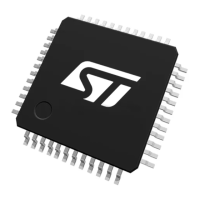RM0444 Rev 5 1299/1390
RM0444 Universal serial bus full-speed host/device interface (USB)
1307
Bit 6 DTOGTX: Data toggle, for transmission transfers
If the endpoint/channel is non-isochronous, this bit contains the required value of the data
toggle bit (0 = DATA0, 1 = DATA1) for the next data packet to be transmitted. Hardware
toggles this bit when the ACK handshake is received from the USB host, following a data
packet transmission. If the endpoint/channel is defined as a control one, hardware sets this
bit to 1 at the reception of a SETUP PID addressed to this endpoint.
If the endpoint/channel is using the double buffer feature, this bit is used to support packet
buffer swapping too (Refer to Section 37.5.3: Double-buffered endpoints and usage in
Device mode)
If the endpoint/channel is isochronous, this bit is used to support packet buffer swapping
since no data toggling is used for this sort of endpoints and only DATA0 packet are
transmitted (refer to Section 37.5.5: Isochronous transfers in Device mode). Hardware
toggles this bit just after the end of data packet transmission, since no handshake is used for
isochronous transfers.
This bit can also be toggled by the software to initialize its value (mandatory when the
endpoint/channel is not a control one) or to force a specific data toggle/packet buffer usage.
When the application software writes 0, the value of DTOGTX remains unchanged, while
writing 1 makes the bit value to toggle. This bit is read/write but it can only be toggled by
writing 1.
Bits 5:4 STATTX[1:0]: Status bits, for transmission transfers
– Device mode
These bits contain the information about the endpoint status, listed in Table 227. These bits
can be toggled by the software to initialize their value. When the application software writes
0, the value remains unchanged, while writing 1 makes the bit value to toggle. Hardware
sets the STATTX bits to NAK, when a correct transfer has occurred (VTTX = 1)
corresponding to a IN or SETUP (control only) transaction addressed to this
channel/endpoint. It then waits for the software to prepare the next set of data to be
transmitted.
Double-buffered bulk endpoints implement a special transaction flow control, which controls
the status based on buffer availability condition (Refer to Section 37.5.3: Double-buffered
endpoints and usage in Device mode).
If the endpoint is defined as isochronous, its status can only be “VALID” or “DISABLED”.
Therefore, the hardware cannot change the status of the channel/endpoint/channel after a
successful transaction. If the software sets the STATTX bits to ‘STALL’ or ‘NAK’ for an
isochronous channel/endpoint, the USB peripheral behavior is not defined. These bits are
read/write but they can be only toggled by writing 1.
– Host mode
The STATTX bits contain the information about the channel status. Refer to Table 227 for the
full descriptions (“Host mode” descriptions). Whereas in Device
mode, these bits contain the
status that are given out on the following transaction, in Host mode they capture the status
last received from the device. If a NAK is received, STATTX contains the value indicating
NAK.
Bits 3:0 EA[3:0]: endpoint/channel address
– Device mode
Software must write in this field the 4-bit address used to identify the transactions directed to
this endpoint. A value must be written before enabling the corresponding endpoint.
– Host mode
Software must write in this field the 4-bit address used to identify the channel addressed by
the host transaction.

